Information
LHCb-PAPER-2015-017
CERN-PH-EP-2015-107
arXiv:1505.01505 [PDF]
(Submitted on 06 May 2015)
Phys. Rev. D92 (2015) 012012
Inspire 1367298
Tools
Abstract
The Dalitz plot distribution of $B^0 \rightarrow \bar{D}^0 K^+ \pi^-$ decays is studied using a data sample corresponding to $3.0\rm{fb}^{-1}$ of $pp$ collision data recorded by the LHCb experiment during 2011 and 2012. The data are described by an amplitude model that contains contributions from intermediate $K^*(892)^0$, $K^*(1410)^0$, $K^*_2(1430)^0$ and $D^*_2(2460)^-$ resonances. The model also contains components to describe broad structures, including the $K^*_0(1430)^0$ and $D^*_0(2400)^-$ resonances, in the $K\pi$ S-wave and the $D\pi$ S- and P-waves. The masses and widths of the $D^*_0(2400)^-$ and $D^*_2(2460)^-$ resonances are measured, as are the complex amplitudes and fit fractions for all components included in the amplitude model. The model obtained will be an integral part of a future determination of the angle $\gamma$ of the CKM quark mixing matrix using $B^0 \rightarrow D K^+ \pi^-$ decays.
Figures and captions
|
Decay diagrams for the quasi-two-body contributions to $ B ^0 \rightarrow D K ^+ \pi ^- $ from (a) $ B ^0 \rightarrow D K ^* (892)^0$ and (b) $ B ^0 \rightarrow D^{*}_{2}(2460)^{-} K ^+ $ decays. |
Fig1a.pdf [14 KiB] HiDef png [43 KiB] Thumbnail [24 KiB] *.C file |
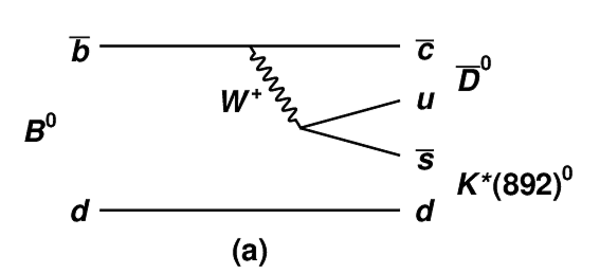
|
|
Fig1b.pdf [14 KiB] HiDef png [43 KiB] Thumbnail [24 KiB] *.C file |

|
|
|
Results of the fit to the $ B $ candidate invariant mass distribution with (a) linear and (b) logarithmic $y$-axis scales. The components are as described in the legend. |
Fig2a.pdf [32 KiB] HiDef png [334 KiB] Thumbnail [268 KiB] *.C file |

|
|
Fig2b.pdf [30 KiB] HiDef png [304 KiB] Thumbnail [233 KiB] *.C file |

|
|
|
Distribution of $ B ^0 \rightarrow \overline{ D }{} {}^0 K ^+ \pi ^- $ candidates in the signal region over (a) the Dalitz plot and (b) the square Dalitz plot. The definition of the square Dalitz plot is given in Sec. ???. |
Fig3a.pdf [49 KiB] HiDef png [157 KiB] Thumbnail [92 KiB] *.C file |
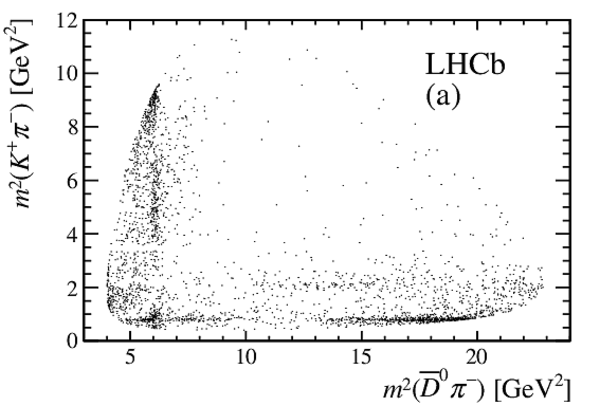
|
|
Fig3b.pdf [49 KiB] HiDef png [178 KiB] Thumbnail [114 KiB] *.C file |

|
|
|
Efficiency variation as a function of SDP position for candidates triggered by (a) signal decay products and (b) by the rest of the event. The vertical white stripe is due to the $ D ^*$ veto and the curved white band is due to the $\overline{ D }{} {}^0$ veto. |
Fig4a.pdf [210 KiB] HiDef png [1 MiB] Thumbnail [671 KiB] *.C file |

|
|
Fig4b.pdf [209 KiB] HiDef png [1 MiB] Thumbnail [625 KiB] *.C file |

|
|
|
SDP distributions of the background contributions from (a) combinatorial background and (b) $ B ^0 \rightarrow \overline{ D }{} {}^{(*)0} \pi ^+ \pi ^- $ decays. |
Fig5a.pdf [19 KiB] HiDef png [200 KiB] Thumbnail [180 KiB] *.C file |
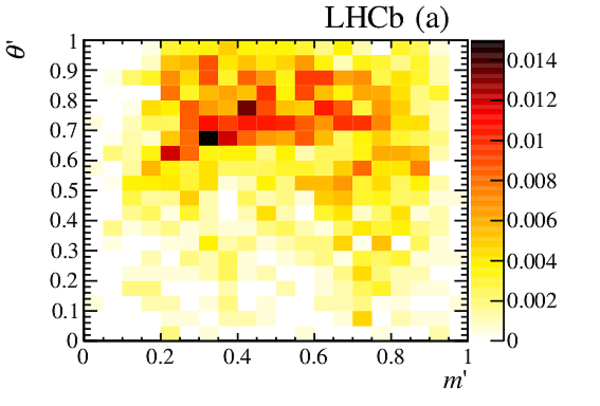
|
|
Fig5b.pdf [30 KiB] HiDef png [265 KiB] Thumbnail [247 KiB] *.C file |
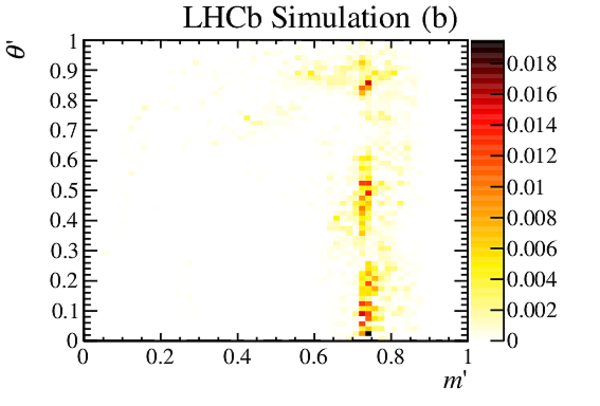
|
|
|
Projections of the data and amplitude fit results onto (a) $m(\overline{ D }{} {}^0 \pi ^- )$, (c) $m( K ^+ \pi ^- )$ and (e) $m(\overline{ D }{} {}^0 K ^+ )$, with the same projections shown in (b), (d) and (f) with a logarithmic $y$-axis scale. Components are described in the legend. |
Fig6a.pdf [32 KiB] HiDef png [277 KiB] Thumbnail [194 KiB] *.C file |

|
|
Fig6b.pdf [24 KiB] HiDef png [520 KiB] Thumbnail [338 KiB] *.C file |

|
|
|
Fig6c.pdf [31 KiB] HiDef png [251 KiB] Thumbnail [183 KiB] *.C file |
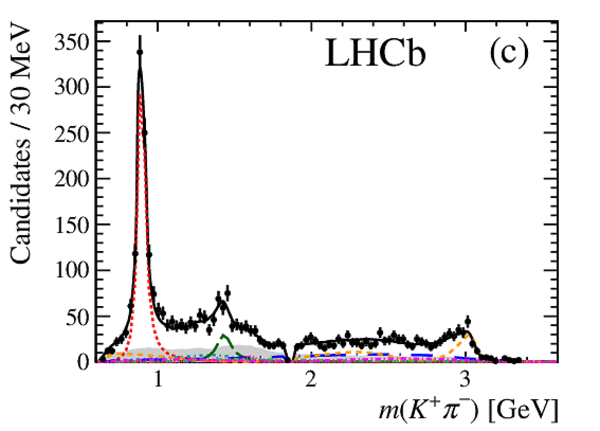
|
|
|
Fig6d.pdf [23 KiB] HiDef png [536 KiB] Thumbnail [336 KiB] *.C file |
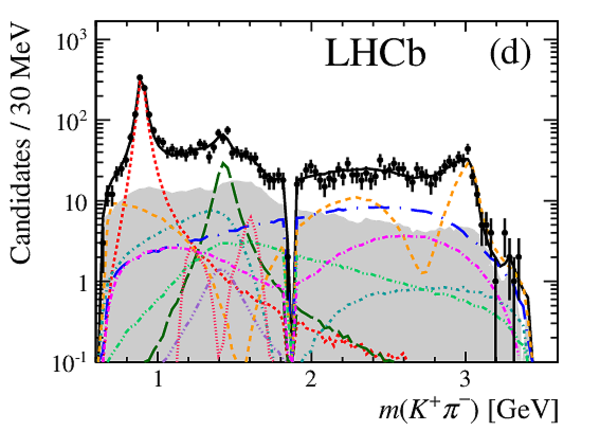
|
|
|
Fig6e.pdf [32 KiB] HiDef png [319 KiB] Thumbnail [230 KiB] *.C file |

|
|
|
Fig6f.pdf [24 KiB] HiDef png [547 KiB] Thumbnail [352 KiB] *.C file |

|
|
|
Fig6leg.pdf [12 KiB] HiDef png [63 KiB] Thumbnail [53 KiB] *.C file |

|
|
|
Projections of the data and amplitude fit results onto (a) $m(\overline{ D }{} {}^0 \pi ^- )$ in the $D^*_2(2460)^-$ region and (b) the low $m( K ^+ \pi ^- )$ region. Components are as shown in Fig. ???. |
Fig7a.pdf [26 KiB] HiDef png [319 KiB] Thumbnail [242 KiB] *.C file |

|
|
Fig7b.pdf [32 KiB] HiDef png [266 KiB] Thumbnail [203 KiB] *.C file |

|
|
|
Projections of the data and amplitude fit results onto $\cos \theta(\overline{ D }{} {}^0 \pi ^- )$ in the mass ranges (a) $2.04 < m(\overline{ D }{} {}^0 \pi ^- ) < 2.35 \mathrm{ Ge V} $ and (b) $2.35 < m(\overline{ D }{} {}^0 \pi ^- ) < 2.55 \mathrm{ Ge V} $. Components are as shown in Fig. ???. |
Fig8a.pdf [35 KiB] HiDef png [327 KiB] Thumbnail [240 KiB] *.C file |
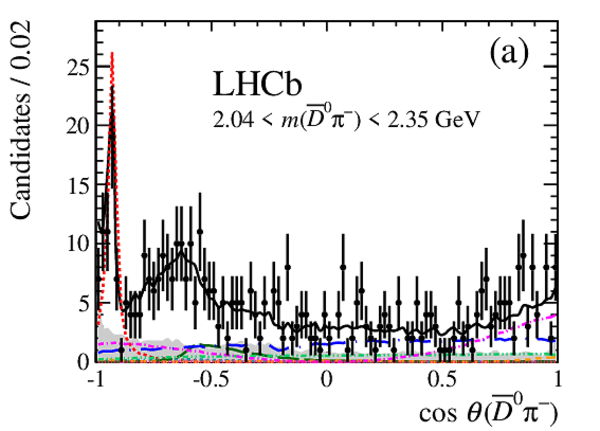
|
|
Fig8b.pdf [33 KiB] HiDef png [319 KiB] Thumbnail [248 KiB] *.C file |
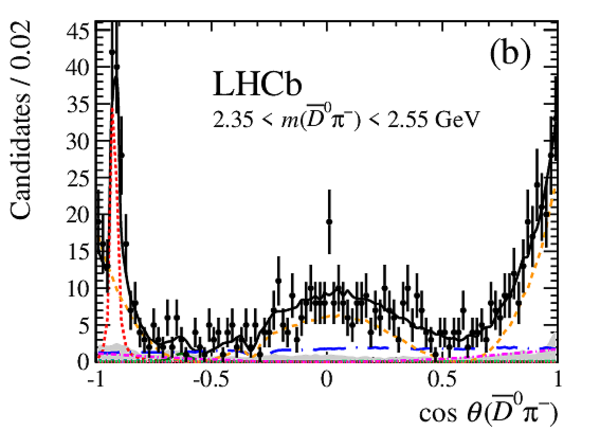
|
|
|
Projections of the data and amplitude fit results onto $\cos \theta( K ^+ \pi ^- )$ in the mass ranges (a) $m( K ^+ \pi ^- ) < 0.8 \mathrm{ Ge V} $, (b) $0.8 < m( K ^+ \pi ^- ) < 1.0 \mathrm{ Ge V} $, (c) $1.0 < m( K ^+ \pi ^- ) < 1.3 \mathrm{ Ge V} $ and (d) $1.4 < m( K ^+ \pi ^- ) < 1.5 \mathrm{ Ge V} $. Components are as shown in Fig. ???. |
Fig9a.pdf [31 KiB] HiDef png [277 KiB] Thumbnail [207 KiB] *.C file |
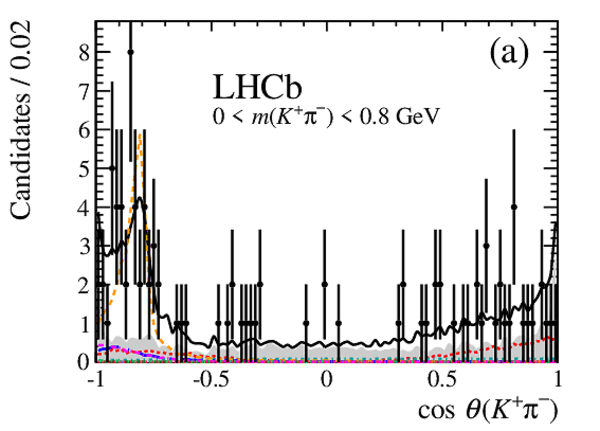
|
|
Fig9b.pdf [31 KiB] HiDef png [264 KiB] Thumbnail [207 KiB] *.C file |
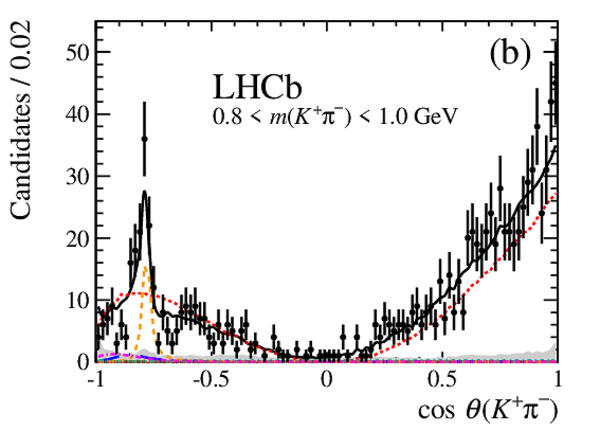
|
|
|
Fig9c.pdf [32 KiB] HiDef png [260 KiB] Thumbnail [189 KiB] *.C file |

|
|
|
Fig9d.pdf [34 KiB] HiDef png [282 KiB] Thumbnail [212 KiB] *.C file |
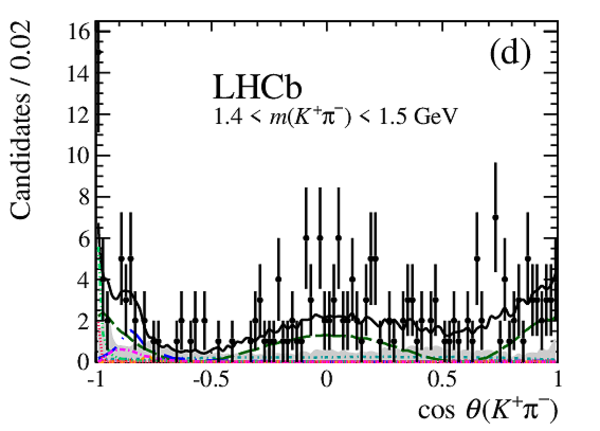
|
|
|
Background-subtracted and efficiency-corrected Legendre moments up to order 7 calculated as a function of $m(\overline{ D }{} {}^0 \pi ^- )$ for data (black data points) and the fit result (solid blue curve). |
Fig10a.pdf [16 KiB] HiDef png [175 KiB] Thumbnail [173 KiB] *.C file |
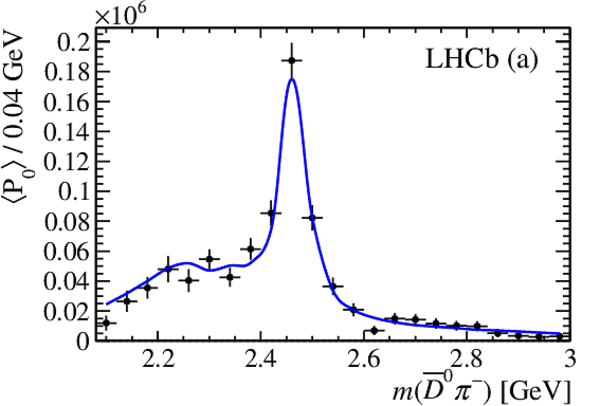
|
|
Fig10b.pdf [16 KiB] HiDef png [170 KiB] Thumbnail [172 KiB] *.C file |
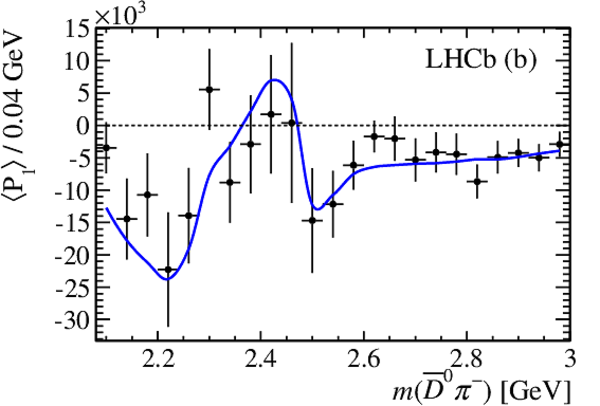
|
|
|
Fig10c.pdf [16 KiB] HiDef png [155 KiB] Thumbnail [157 KiB] *.C file |

|
|
|
Fig10d.pdf [16 KiB] HiDef png [153 KiB] Thumbnail [150 KiB] *.C file |

|
|
|
Fig10e.pdf [16 KiB] HiDef png [155 KiB] Thumbnail [150 KiB] *.C file |

|
|
|
Fig10f.pdf [16 KiB] HiDef png [156 KiB] Thumbnail [155 KiB] *.C file |

|
|
|
Fig10g.pdf [16 KiB] HiDef png [155 KiB] Thumbnail [153 KiB] *.C file |

|
|
|
Fig10h.pdf [16 KiB] HiDef png [154 KiB] Thumbnail [155 KiB] *.C file |

|
|
|
Background-subtracted and efficiency-corrected Legendre moments up to order 7 calculated as a function of $m( K ^+ \pi ^- )$ for data (black data points) and the fit result (solid blue curve). |
Fig11a.pdf [16 KiB] HiDef png [162 KiB] Thumbnail [154 KiB] *.C file |

|
|
Fig11b.pdf [16 KiB] HiDef png [156 KiB] Thumbnail [150 KiB] *.C file |
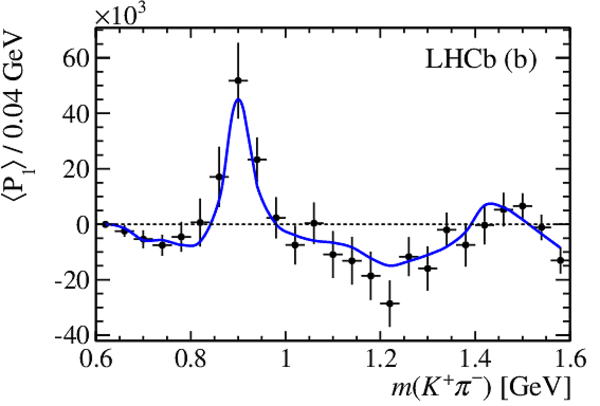
|
|
|
Fig11c.pdf [16 KiB] HiDef png [163 KiB] Thumbnail [153 KiB] *.C file |

|
|
|
Fig11d.pdf [16 KiB] HiDef png [157 KiB] Thumbnail [157 KiB] *.C file |

|
|
|
Fig11e.pdf [16 KiB] HiDef png [163 KiB] Thumbnail [163 KiB] *.C file |

|
|
|
Fig11f.pdf [16 KiB] HiDef png [152 KiB] Thumbnail [151 KiB] *.C file |

|
|
|
Fig11g.pdf [16 KiB] HiDef png [160 KiB] Thumbnail [162 KiB] *.C file |

|
|
|
Fig11h.pdf [17 KiB] HiDef png [156 KiB] Thumbnail [160 KiB] *.C file |

|
|
|
Differences between the data SDP distribution and the fit model across the SDP, in terms of the per-bin pull. |
Fig12.pdf [19 KiB] HiDef png [140 KiB] Thumbnail [123 KiB] *.C file |
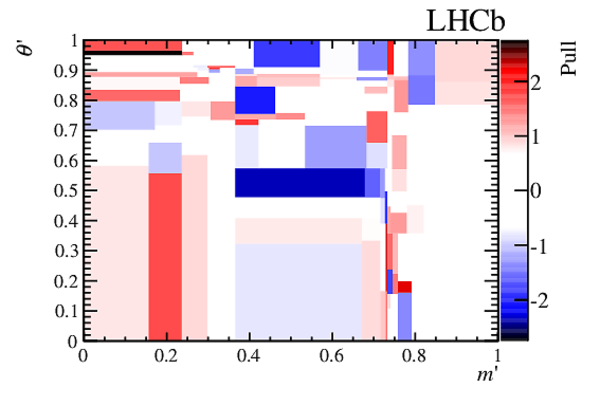
|
|
Animated gif made out of all figures. |
PAPER-2015-017.gif Thumbnail |

|
Tables and captions
|
Yields from the fit to the $\overline{ D }{} {}^0 K ^+ \pi ^- $ data sample. The full mass range is $5100$--$5900\mathrm{ Me V} $ and the signal region is $5248.55$--$5309.05\mathrm{ Me V} $. |
Table_1.pdf [54 KiB] HiDef png [92 KiB] Thumbnail [47 KiB] tex code |

|
|
Signal contributions to the fit model, where parameters and uncertainties are taken from Ref. \cite{PDG2014}. The models are described in Sec. ???. |
Table_2.pdf [58 KiB] HiDef png [85 KiB] Thumbnail [37 KiB] tex code |

|
|
Masses and widths $(\mathrm{Me V} )$ determined in the fit to data, with statistical uncertainties only. |
Table_3.pdf [43 KiB] HiDef png [52 KiB] Thumbnail [23 KiB] tex code |

|
|
Complex coefficients and fit fractions determined from the Dalitz plot fit. Uncertainties are statistical only. Note that the fit fractions, magnitudes and phases are derived quantities. |
Table_4.pdf [50 KiB] HiDef png [104 KiB] Thumbnail [48 KiB] tex code |

|
|
Experimental systematic uncertainties on the fit fractions (%) and masses and widths $(\mathrm{Me V} )$. Uncertainties given on the central values are statistical only. |
Table_5.pdf [49 KiB] HiDef png [103 KiB] Thumbnail [47 KiB] tex code |

|
|
Model uncertainties on the fit fractions (%) and masses and widths $(\mathrm{Me V} )$. Uncertainties given on the central values are statistical only. |
Table_6.pdf [49 KiB] HiDef png [98 KiB] Thumbnail [44 KiB] tex code |

|
|
Results for the complex amplitudes and their uncertainties presented (top) in terms of real and imaginary parts and (bottom) in terms and magnitudes and phases. The three quoted errors are statistical, experimental systematic and model uncertainties, respectively. |
Table_7.pdf [48 KiB] HiDef png [82 KiB] Thumbnail [31 KiB] tex code |

|
|
Results for the fit fractions and their uncertainties (%). The three quoted errors are statistical, experimental systematic and model uncertainties, respectively. Upper limits are given at 90 % (95 %) confidence level. |
Table_8.pdf [47 KiB] HiDef png [108 KiB] Thumbnail [56 KiB] tex code |

|
|
Results for the product branching fractions. The four quoted errors are statistical, experimental systematic, model and PDG uncertainties, respectively. Upper limits are given at 90 % (95 %) confidence level. |
Table_9.pdf [48 KiB] HiDef png [101 KiB] Thumbnail [49 KiB] tex code |

|
|
Results for the branching fractions. The four quoted errors are statistical, experimental systematic, model and PDG uncertainties, respectively. Upper limits are given at 90 % (95 %) confidence level. |
Table_10.pdf [46 KiB] HiDef png [66 KiB] Thumbnail [31 KiB] tex code |

|
|
Statistical correlations between the real ($x$) and imaginary ($y$) parts of the complex coefficients that are free parameters of the fit. Correlations with the masses ($m$) and widths ($\Gamma$) that are determined from the fit are also included. The correlations are determined from the same sample of simulated pseudoexperiments used to evaluate systematic uncertainties. The labels correspond to: (0) $ K ^* (892)^{0}$, (1) $ K ^* (1410)^{0}$, (2) $ K ^*_{0}(1430)^{0}$, (3) LASS nonresonant, (4) $ K ^*_{2}(1430)^{0}$, (5) $D^{*}_{0}(2400)^{-}$, (6) $D^{*}_{2}(2460)^{-}$, (7) $D\pi$ S-wave (dabba), (8) $D\pi$ P-wave (EFF). |
Table_11.pdf [36 KiB] HiDef png [81 KiB] Thumbnail [29 KiB] tex code |

|
|
Statistical correlations between the magnitudes ($a$) and phases ($\Delta$) of the complex coefficients that are free parameters of the fit. Correlations with the masses ($m$) and widths ($\Gamma$) that are determined from the fit are also included. The correlations are determined from the same sample of simulated pseudoexperiments used to evaluate systematic uncertainties. The labels correspond to: (0) $ K ^* (892)^{0}$, (1) $ K ^* (1410)^{0}$, (2) $ K ^*_{0}(1430)^{0}$, (3) LASS nonresonant, (4) $ K ^*_{2}(1430)^{0}$, (5) $D^{*}_{0}(2400)^{-}$, (6) $D^{*}_{2}(2460)^{-}$, (7) $D\pi$ S-wave (dabba), (8) $D\pi$ P-wave (EFF). |
Table_12.pdf [36 KiB] HiDef png [80 KiB] Thumbnail [28 KiB] tex code |

|
|
Interference fit fractions (%) from the nominal DP fit. The amplitudes are all pairwise products involving: ($A_{0}$) $ K ^* (892)^{0}$, ($A_{1}$) $ K ^* (1410)^{0}$, ($A_{2}$) $ K ^*_{0}(1430)^{0}$, ($A_{3}$) LASS nonresonant, ($A_{4}$) $ K ^*_{2}(1430)^{0}$, ($A_{5}$) $D^{*}_{0}(2400)^{-}$, ($A_{6}$) $D^{*}_{2}(2460)^{-}$, ($A_{7}$) $D\pi$ S-wave (dabba), ($A_{8}$) $D\pi$ P-wave (EFF). The diagonal elements are the same as the conventional fit fractions. |
Table_13.pdf [33 KiB] HiDef png [47 KiB] Thumbnail [22 KiB] tex code |

|
|
Statistical uncertainties on the interference fit fractions (%). The amplitudes are all pairwise products involving: ($A_{0}$) $ K ^* (892)^{0}$, ($A_{1}$) $ K ^* (1410)^{0}$, ($A_{2}$) $ K ^*_{0}(1430)^{0}$, ($A_{3}$) LASS nonresonant, ($A_{4}$) $ K ^*_{2}(1430)^{0}$, ($A_{5}$) $D^{*}_{0}(2400)^{-}$, ($A_{6}$) $D^{*}_{2}(2460)^{-}$, ($A_{7}$) $D\pi$ S-wave (dabba), ($A_{8}$) $D\pi$ P-wave (EFF). The diagonal elements are the same as the conventional fit fractions. |
Table_14.pdf [27 KiB] HiDef png [70 KiB] Thumbnail [33 KiB] tex code |

|
|
Experimental systematic uncertainties on the interference fit fractions (%). The amplitudes are all pairwise products involving: ($A_{0}$) $ K ^* (892)^{0}$, ($A_{1}$) $ K ^* (1410)^{0}$, ($A_{2}$) $ K ^*_{0}(1430)^{0}$, ($A_{3}$) LASS nonresonant, ($A_{4}$) $ K ^*_{2}(1430)^{0}$, ($A_{5}$) $D^{*}_{0}(2400)^{-}$, ($A_{6}$) $D^{*}_{2}(2460)^{-}$, ($A_{7}$) $D\pi$ S-wave (dabba), ($A_{8}$) $D\pi$ P-wave (EFF). The diagonal elements are the same as the conventional fit fractions. |
Table_15.pdf [27 KiB] HiDef png [69 KiB] Thumbnail [33 KiB] tex code |

|
|
Model uncertainties on the interference fit fractions (%). The amplitudes are all pairwise products involving: ($A_{0}$) $ K ^* (892)^{0}$, ($A_{1}$) $ K ^* (1410)^{0}$, ($A_{2}$) $ K ^*_{0}(1430)^{0}$, ($A_{3}$) LASS nonresonant, ($A_{4}$) $ K ^*_{2}(1430)^{0}$, ($A_{5}$) $D^{*}_{0}(2400)^{-}$, ($A_{6}$) $D^{*}_{2}(2460)^{-}$, ($A_{7}$) $D\pi$ S-wave (dabba), ($A_{8}$) $D\pi$ P-wave (EFF). The diagonal elements are the same as the conventional fit fractions. |
Table_16.pdf [27 KiB] HiDef png [70 KiB] Thumbnail [34 KiB] tex code |

|
Created on 02 May 2024.
